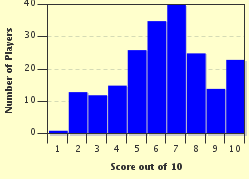Quiz Answer Key and Fun Facts
1. Originally a Czech tank with the designation LT vz 38, it was then redesignated for use in the German army and Panzer divisions. It most prominently served during the Fall of France in May and June 1940, and was rarely used thereafter. It was the basis for the famous Hetzer tank destroyer. What was its German designation?
2. Supposed to be the latest American medium tank of the time, this tank was to be armed with an M3 37mm anti-tank gun. However, after the fall of both France and Poland in Europe, many American engineers deemed the day of the 37mm gun had passed and a 75mm was needed to penetrate heavier tank armor. By 1941 the tank was sold in large numbers to the United Kingdom, who customized it to their own preferences.
3. Armed with an excellent M3 90mm cannon, this tank was the first American tank with sufficient armor and power to fight and defeat the famed "Tiger" tank in a straight shooting match.
4. This tank was deployed by the Commonwealth in early WWII and participated widely with the British Expeditionary Force in France in 1940. Despite being slow, unmaneuverable and carrying a relatively weak armament, it had such thick armor that none among the Axis anti-tank weapons could penetrate it.
5. The M4 Sherman, originally fitted with a short 75mm gun, was, despite it's weak armament and thin armor, was mass-produced and reliable throughout the war. After the debut of the German "Tiger" tank in Tunisia in 1943, it was deemed the short 75mm had to be replaced by a longer, bigger cannon. It was eventually replaced by a long-barreled 76mm cannon with multitudes the original armor-piercing power of the first-variant Sherman. What model was this?
6. Made to replace the Panzerkampfwagen VI "Tiger" on the battlefield, the "Tiger II" was equipped with slanted, thicker armor, a revolutionary turret design, and an even more powerful 88mm KwK 43 L/71 cannon capable of penetrating the armor of a T-34 at extremely long ranges. Known as the "Royal Tiger" to Commonwealth troops and the "Konigstiger" to their German users, what where these devastating tanks known as to American and allied troops?
7. Designed as the successor to the famed and extremely efficient - on the battlefield and at the depots - T-34 model tank, this tank was the first Russian tank armed with a 100mm gun as its armament. Despite less than 2,000 having been built, it was the predecessor to the extremely successful T-54/55 Main battle tanks, holding the record of being the most produced tanks of all time. What is this tank?
8. This tank was the most-produced of all Japanese tanks during the war. Designated a light tank, it was, in the eyes of many other nations, in fact a tankette do to its minute size. Armed with a short 37mm gun and wielding a machine gun in the rear of the turret, it served superbly in China and was deemed a successful tank until it met American and British armored units in the Pacific Theatre.
9. Initially armed with a 76.2mm gun and wielding sloped armor and American-derived Christie suspension (developed by the tank designer Walter J. Christie), the tank was produced in some numbers until Operation Barbarossa. No German anti-tank weapons were able to penetrate its armor other than the mighty "88". These machines of war were known to penetrate German lines alone and wreak havoc before being destroyed.
10. Armed with a PaK 44 L/55 12.8cm weapon (the largest anti-tank weapon fitted to any vehicle during the war), this tank destroyer had the thickest armor of any vehicle of the war, and also utilized sloped armor. Less than 500 were produced and deployed, however, and it had little effect on the advance of enemy troops. Despite these failings, it was feared by any who faced it.
Source: Author
MastahCheef117
This quiz was reviewed by FunTrivia editor
bloomsby before going online.
Any errors found in FunTrivia content are routinely corrected through our feedback system.

